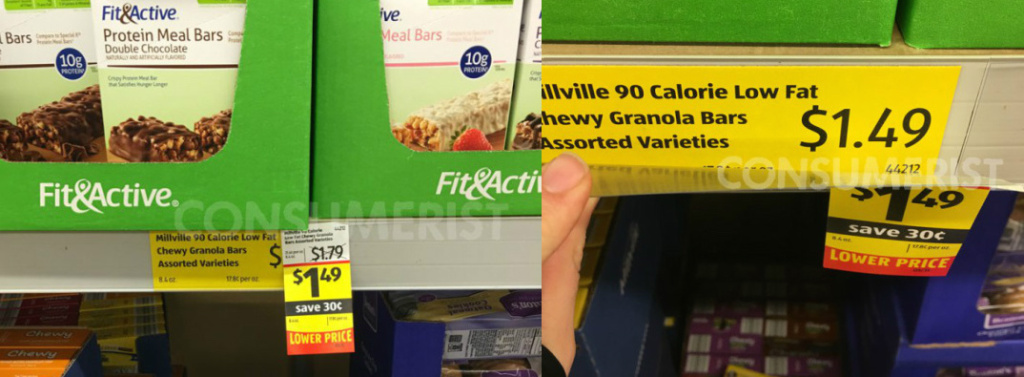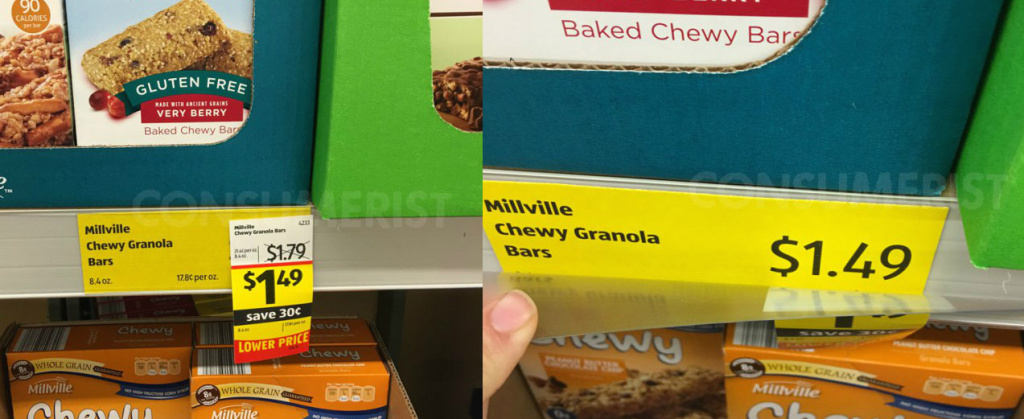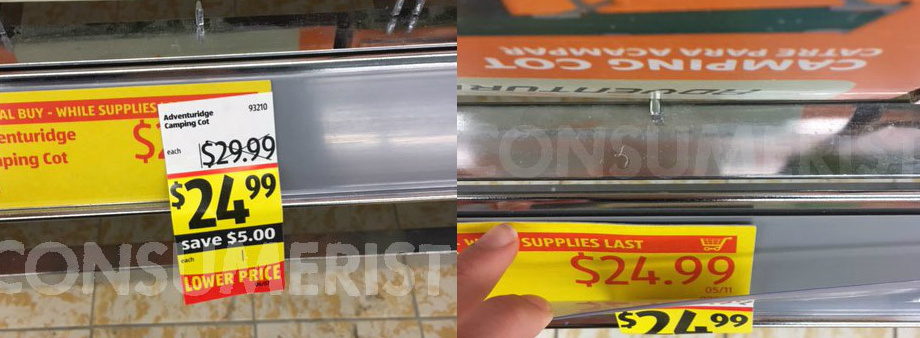Why Is Aldi Covering Actual Prices With Confusing “Lower Price” Stickers?
When you’re in the supermarket and see a big, loud “Lower Price” sticker covering up an everyday price and showing a discount of anywhere from $.20 to $5, you’d expect that the price being covered up would be the original, higher amount. That’s why some Aldi shoppers are confused about why the discounted price on the sticker is the same as the price it’s covering up.
Consumerist reader E. was shopping at an Aldi in Connecticut when she realized that the price being advertised on these “Lower Price” labels was identical to the price underneath.
The original labels were covered with a temporary sales label. All you have to do is just peel off the sale label to see that the original price is same as the sale price, E. says.
For example, a product’s sales tag lists the original price at $1.49. That number is crossed out and the tag shows a new price of $1.19, with a smaller line that shows “save $.30.” However, when you peel back the sale tag, the normal price display shows the product is… $1.19.
E. tells Consumerist that she asked a manager on duty at her store to explain these price tags. He said he was unsure and would check. She has yet to hear back from the grocer.
We went to an Aldi store near the Consumerist Midwest Outpost in Iowa to see if the issue was a one-off or perhaps a company-wide practice.
Inside the store we found roughly a dozen items with the same sale tags that E. described.
Was this a case of a company falsely inflating original prices to make discounts look more attractive? Several retailers have been accused of that type of allegedly deceptive practice, but a rep for Aldi tells Consumerist that there is no such trickery here.
- When a new lower price is promoted in-store, it is not a sale price, it is the new price for the product that will be offered on an ongoing basis. When we lower a price, we add two price signs, one that advertises the new lower price and one behind it with the new price. This allows our teams to work efficiently.
In other words, the “Lower Price” sticker is really just a way for Aldi to advertise that a price has been reduced. The more permanent label underneath has the identical price because that is what the item will continue to be sold at after the promotional sticker has been removed.
This is efficient for Aldi. It puts up both labels at the same time and can just take off the “Lower Price” sticker after a few weeks without having to adjust the label on the shelf. Similarly, if some rambunctious child (or errant shopping cart) knocks off the sticker, the remaining label will still accurately reflect the price.
However, it may be confusing to shoppers who are used to other stores using these sorts of stickers to advertise temporary discounts. Additionally, consumers are more aware of potentially misleading pricing practices after some high-profile lawsuits against national retailers.
Kohl’s, Kate Spade, Macy’s and Bloomingdales have all been accused, in various lawsuits, of deliberately marking up products to higher prices in order to advertise deep discounts.
Retailers — a grocer, big box store, or other company — are required to abide by a Federal Trade Commission guidelines when advertising sales prices.
“One of the most commonly used forms of bargain advertising is to offer a reduction from the advertiser’s own former price for an article,” the guidelines state. “If the former price is the actual, bona fide price at which the article was offered to the public on a regular basis for a reasonably substantial period of time, it provides a legitimate basis for the advertising of a price comparison.”
However, when the “original” price is not bona fide, “the purchaser is not receiving the unusual value he expects. In such a case, the ‘reduced’ price is, in reality, probably just the seller’s regular price.”
Still, the guidelines note that a former price is not necessarily fictitious just because no sale was advertised for the original price.
“The advertiser should be especially careful, however, in such a case, that the price is one at which the product was openly and actively offered for sale, for a reasonably substantial period of time, in the recent, regular course of his business, honestly and in good faith—and, of course, not for the purpose of establishing a fictitious higher price on which a deceptive comparison might be based.”
Want more consumer news? Visit our parent organization, Consumer Reports, for the latest on scams, recalls, and other consumer issues.






